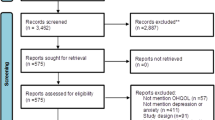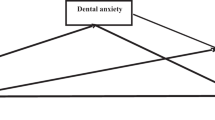Abstract
Objective
To investigate the relationship between temperament traits and dental fear and anxiety (DFA) in children and adolescents by the means of a systematic review (PROSPERO #CRD42020207578).
Methods
The PEO (Population, Exposure, and Outcome) strategy was followed using children and adolescents as the population, temperament as the exposure, and DFA as the outcome. A systematic search for observational studies (cross-sectional, case-control, and cohort) without restrictions on year or language of publication was performed in seven databases (PubMed, Web of Science, Scopus, Lilacs, Embase, Cochrane, and PsycINFO) in September 2021. Grey literature search was performed in OpenGrey, Google Scholar, and in the reference list of included studies. Study selection, data extraction, and risk of bias assessment were carried out independently by two reviewers. The Fowkes and Fulton Critical Assessment Guideline was used to assess methodological quality of each study included. The GRADE approach was performed to determine the certainty of evidence of relationship between temperament traits.
Results
This study recovered 1362 articles, of which 12 were included. Despite the high heterogeneity of methodological aspects, qualitative synthesis by subgroups showed a positive association/correlation between emotionality, neuroticism, and shyness with DFA in children and adolescents. Different subgroups analysis showed similar results. Eight studies were classified as having low methodological quality.
Conclusion
The main shortcoming of the included studies is the high risk of bias and a very low certainty of evidence. Within its limitations, children and adolescents with a temperament-like emotionality/neuroticism and shyness are more likely to present higher DFA.
This is a preview of subscription content, access via your institution
Access options
Subscribe to this journal
Receive 4 print issues and online access
$259.00 per year
only $64.75 per issue
Buy this article
- Purchase on Springer Link
- Instant access to full article PDF
Prices may be subject to local taxes which are calculated during checkout



Similar content being viewed by others
References
Öhman A. Fear and anxiety: overlaps and dissociation. In: Lewis M; Haviland-Jones JM; Barret LF Handbook of Emotions. Chap 44, pp. 709–29. New York: The Guilford Press. 2008.
American Psychiatric Association (APA). Diagnostic and Statistical Manual of Mental Disorders, 5th Edition: American Psychiatric Association, Washington, DC. 2014.
Klingberg G, Broberg AG. Dental fear/anxiety and dental behaviour management problems in children and adolescents: a review of prevalence and concomitant psychological factors. Int J Paediatr Dent. 2007;17:391–406.
Cianetti S, Lombardo G, Lupatelli E, Pagano S, Abraha I, Montedori A, et al. Dental fear/anxiety among children and adolescents. A systematic review. Eur J Paediatr Dent. 2017;18:121–30.
Grisolia BM, Santos APP, Dhyppolito IM, Buchanan H, Hill K, Oliveira BH. Prevalence of dental anxiety in children and adolescents globally: a systematic review and meta-analyses. Int J Paediatr Dent. 2020;31:168–83.
Morgan AG, Porrit J. Background and prevalence on dental fear and anxiety. In: Campell, C Dental fear and anxiety in pediatric patients. Chap 1, pp. 3–19. Cham: Springer. 2017.
Ramos-Jorge J, Marques LS, Homem MA, Paiva SM, Ferreira MC, Ferreira FO, et al. Degree of dental anxiety in children with and without toothache: prospective assessment. Int J Paediatr Dent. 2013;23:125–30.
Colares V, Franca C, Ferreira A, Amorim Filho HA, Oliveira MCA. Dental anxiety and dental pain in 5- to 12-year old children in Recife, Brazil. Eur Arch Paediatr Dent. 2013;14:15–19.
Busato P, Garbin RR, Santos CN, Paranhos LR, Rigo L. Influence of maternal anxiety on child anxiety during dental care: cross-sectional study. São Paulo Med J. 2017;135:116–22.
Stenebrand A, Boman UW, Hakeberg M. Dental anxiety and symptoms of general anxiety and depression in 15-year-olds. Int J Dent Hyg. 2013;11:99–104.
Abanto J, Vidigal EA, Carvalho TS, Sá SNC, Bönecker M. Factors determining dental anxiety in preschool children with severe dental caries. Braz Oral Res. 2017;31:e13.
Buss AH, Plomin R. Temperament: early developing personality traits. 193p. New Jersey: Lawrence Erlbaum Associates. 1984.
Pereira PC, Guzzo RSL. Individual differences: temperament and personality; importance of the theory. Rev Estudos de Psicologia. 2002;19:91–100.
Eysenck HJ, Eysenck SBG. Manual of the Eysenck Personality Inventory. pp 26. Kent: Hodder and Stoughton. 1964.
Eysenck HJ. The definition and measurement of psychoticism. Person Individ Diff. 1992;13:757–85.
Quinonez R, Santos RG, Boyar R, Cross H. Temperament and trait anxiety as predictors of child behavior prior to general anesthesia for dental surgery. Pediatr Dent. 1997;19:427–31.
Stenebrand A, Boman UW, Hakeberg M. Dental anxiety and temperament in 15-year-olds. Acta Odontol Scand. 2013;71:15–24.
Jain A, Suprabha BS, Shenoy R, Rao A. Association of Temperament with dental anxiety and behaviour of the preschool child during the initial dental visit. Eur J Oral Sci. 2019;127:147–55.
Toledano M, Osorio R, Aguilera FS, Pegalajar J. Children’s dental anxiety: influence of personality and intelligence factors. Int J Paediatr Dent. 1995;5:23–28.
Kim SH, Baik BJ, Kim JG, Yang YM, Kwon BW. Relationship of dental anxiety between child and parent during dental visit. J Korean Acad Pediatr Dent. 2005;32:370–5.
Page MJ, McKenzie JE, Bossuyt PM, Boutron I, Hoffmann TC, Mulrow CD, et al. The PRISMA 2020 statement: an update guideline for reporting systematic reviews. BMJ. 2021;372:n71.
Moola S, Munn Z, Sears K, Sfetcu R, Currie M, Lisy K, et al. Conducting systematyc reviews of association (etiology): The Joanna Briggs Institute’s approach. Int J Evid Based Health. 2015;13:13–169.
Ouzani M, Hammady H, Fedorowicz Z, Elmagarmid A. Rayyan – a web and mobile app for systematic reviews. Syst Rev. 2016;5:210.
Fowkes FG, Fulton PM. Critical appraisal of published research: Introductory guidelines. BMJ. 1991;302:1136–40.
Ryan R, Hill S. How to GRADE the quality of the evidence. Cochrane Consumers and Communication Group, available at http://cccrg.cochrane.org/author-resources. Version 3.0 December 2016. 2016.
Hulley SB, Cummings SR, Browner WS, Grady D, Hearst N, Newman TB. Delineando a pesquisa clínica: uma abordagem epidemiológica. 2.ed. Porto Alegre: Artmed. 2003.
Venham LL, Murray P, Gaulin-Kremer E. Personality factors affecting the preschool child’s response to dental stress. J Dent Res. 1979;58:2046–51.
Liddell A. Personality characteristics versus medical and dental experiences of dentally anxious children. J Behav Med. 1989;13:183–94.
Kronina L, Rascevska M, Care R. Psychosocial factors correlated with children’s dental anxiety. Stomatologija. 2017;19:84–90.
Pop-Jordanova N, Sarakinova O, Markovska-Simoska S, Loleska S. Anxiety and personality characteristics in children undergoing dental interventions. Pril (Makedon Akad Nauk Umet Odd Med Nauki). 2013;34:93–103.
Sermet O. Emotional and medical factors in child dental anxiety. J Child Psychol Psychatry. 1974;15:313–21.
Klingberg G, Broberg AG. Temperament and child dental fear. Pediatr Dent. 1998;20:237–43.
Kalra N, Sabherwal P, Tyagi R, Khatri A, Srivastava S. Relationship between subjective and objective measures of anticipatory anxiety prior to extraction procedures in 8- to 12-year-old children. J Dent Anesth Pain Med. 2021;21:119–28.
Klingberg G, Berggren U, Carlsson SG, et al. Child dental fear: cause-related factors and clinical effects. Eur J Oral Sci. 1995;103:405–12.
Porrit J, Buchanan H, Hall M, GilCchrist F, Marshman Z. Assessing children’s dental anxiety: a systematic review of current measures. Community Dent Oral Epidemiol. 2013;41:130–42.
Cademartori MG, Cara G, Pinto GS, Costa VPP. Validity of the Brazilian version of the dental subscale of Children’s Fear Survey Schedule. Int J Paediatr Dent. 2019;29:736–47.
Brasil. Marco legal: saúde, um direito de adolescentes. Ministério da Saúde, Secretaria de Atenção à Saúde, Área de Saúde do Adolescente e do Jovem. Brasília: Ministério da Saúde, 2007. 60 p.
Klaassen M, Veerkamp J, Hoogstraten J. Predicting dental anxiety. The clinical value of anxiety questionnaires: an explorative study. Eur J Paediatr Dent. 2003;4:171–6.
Elm EV, Altamn DG, Egger M, Pocock SJ, Gotzsche PC, Vandenbroucke JP. The Strengthening the Reporting of Observations Studies in Epidemiology (STROBE) Statement: guidelines for reporting observational studies. J Clin Epidemiol. 2008;61:344–9.
Bedos C, Loignon C. Patient-centered approaches: new models for new challenges. J Can Dent Assoc. 2011;77:b88.
Gluyas H. Patient-centered care: improving healthcare outcomes. Nurs Stand. 2015;30:50–7.
Song Y, Luzzi L, Brennan DS. Trust in dentist-patient relationship: mapping the relevant concepts. Eur J Oral Sci. 2020;128:110–9.
Acknowledgements
This study was supported by the Universidade Federal de Minas Gerais (UFMG), the Universidade Federal do Rio de Janeiro (UFRJ) and the Brazilian Coordination of Higher Education of the Ministry of Education (CAPES).
Author information
Authors and Affiliations
Contributions
All the authors contributed on idea planning and development. ACFP contributed on bibliographic search, data extraction, data analysis, methodological quality assessment, interpretation of results, analysis of certainty of evidence and writing and review of the manuscript. DRC contributed on bibliographic search, data extraction, data analysis, methodological quality assessment, interpretation of results, analysis of certainty of evidence and writing and review of the manuscript. IBF contributed on data analysis and interpretation of the results, writing and review of the final version of the manuscript. MBM contributed on data analysis and interpretation of the results, analysis of certainty of evidence, writing and review of the final version of the manuscript. LCM contributed on data analysis and interpretation of the results, writing and review of the final version of the manuscript. SMP contributed on data analysis and interpretation of the results, writing and review of the final version of the manuscript. CBB contributed on data analysis and interpretation of the results, writing and review of the final version of the manuscript. All authors have revised and approved the final version of the manuscript.
Corresponding author
Ethics declarations
Competing interests
The authors declare no competing interests.
Additional information
Publisher’s note Springer Nature remains neutral with regard to jurisdictional claims in published maps and institutional affiliations.
Supplementary information
Rights and permissions
Springer Nature or its licensor (e.g. a society or other partner) holds exclusive rights to this article under a publishing agreement with the author(s) or other rightsholder(s); author self-archiving of the accepted manuscript version of this article is solely governed by the terms of such publishing agreement and applicable law.
About this article
Cite this article
Paiva, A.C.F., Rabelo-Costa, D., Fernandes, I.B. et al. The relationship between temperament and dental fear and anxiety: a systematic review. Evid Based Dent 24, 42 (2023). https://doi.org/10.1038/s41432-023-00852-0
Received:
Accepted:
Published:
Issue Date:
DOI: https://doi.org/10.1038/s41432-023-00852-0



